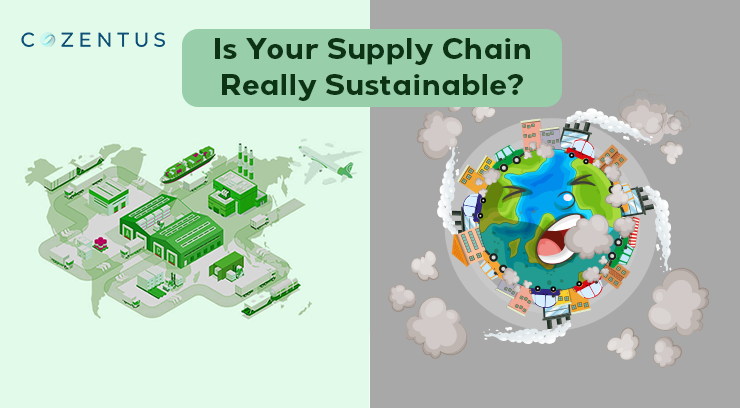The world will change after the Covid-19 pandemic. The February supply shock in China and the ensuing demand shock, when the global economy collapsed showed faults in production planning and supply networks practically everywhere. Trade restrictions and goods shortages showed their shortcomings.
The Russia-Ukraine conflict, geopolitical ramifications, and COVID-19 lockdowns in China have worsened a grave global supply chain situation. Existing Russian limitations and the threat of further contributing to the supply chain issue. While freight markets have minimal direct exposure to Russia and Ukraine, global logistics will confront various risk factors, including airspace limits, consumer demand uncertainties, and China's COVID-19 response. Supply chain demand planning is vital. Read on Cozentus guide about global supply chain crisis, and supply chain visibility solutions.
What Causes a Supply Chain Crisis?
During the COVID-19 shutdown, supply chain crises were apparent due to a "perfect storm" of reasons, including swings in demand, labour shortages, and structural concerns. The Russia-Ukraine crisis and China's COVID-19 lockdowns have lately worsened problems, hurting supply in several industries such as consumer products, metals, food, chemicals, and commodities.
In 2022, the following developments will significantly influence global supply chains.
The current epidemic has impacted every value chain stage, from raw material sourcing to end-user satisfaction. It is putting the majority of organisations throughout the world to the test in terms of commercial, operational, financial, and organisational resilience. Many companies have identified risks and resilience gaps as a result of COVID-19. CEOs want to be on the cutting edge of disruption and innovation, with 67 per cent planning to raise investment in disruption detection and innovation processes. The following are some of the significant conditions affecting supply chains and techniques that top firms use to enhance resilience and agility.
Disruption in logistics
The ongoing global logistics disruptions caused by the COVID-19 pandemic continue to impact businesses and consumers. The shutdown of key global ports and airports in China, South Korea, and the U.S. hinders the flow of consumer products into crucial markets, including North America, Europe, South East Asia, and India.
A catastrophic logistical glitch causes things to pile up in warehouses and shipments to be redirected around the worldwide supply chain. Or they may be delayed near key transportation hubs, limiting companies' ability to import products and restock.
According to several reports, limiting access to imported goods in December 2021 and January 2022 might ruin the festive season in the region. Many organizations across sectors may face disruptions through 2022 and beyond.
Delays in production
COVID-19 production delays have made headlines. Store shelves are bare and shipment delays have risen due to manufacturers vying for a finite pool of crucial inputs and logistical capability. The situation is not entirely hopeless, however the epidemic has increased the need to evaluate and modify supply chain visibility solutions. A new post-pandemic normal is being prepared, with companies assessing and investing in long-term supply chain plans.
Extra inventory may purchase at the lowest possible cost to smooth out fluctuations in supply, but those days are quickly dwindling. Manufacturers are increasingly focusing on risk analysis to make informed decisions about how to structure their supply chains.
The industry is compelled to solve long-standing supply difficulties and re-engineer product requirements, leading to more robust and cost-effective supply chain visibility solutions that may position their particular organisations as leaders in this new normal by maintaining a competitive advantage.
Reliance on a small number of third parties
Despite the risk of depending on "one primary trade partner," many companies have close links to one major supplier, one big customer (or export market), and one crucial supply chain partner. As we recover from COVID-19, many enterprises must ensure sustainable supply chains via non-traditional trade agreements. They seek more suppliers, new markets/customers, and logistical alternatives. Supply chain executives are turning to third- and fourth-party risk monitoring to handle inherent and residual risks in near-real time and cyber and counterfeiting threats.
Increasing technological investment by double
Many organisations' early investments in the preceding 18 months were directed at automating important supply chain nodes (such as intelligent automation utilised to allow efficient, effective, and safe operations), such as retail, warehouses, manufacturing facilities, and even corporate office buildings. Expect increased investment in 2022 as businesses seek to improve critical supply chain planning capabilities through more advanced digital enablers such as cognitive planning. And AI-driven predictive analytics, as well as greater integrity and visibility into secure supply chains through advanced track and trace and blockchain technologies.
Many supply chain managers are now plagued by a lack of visibility across their extensive supply chain visibility solutions, owing to many nodes and participants. Leading firms are using modern technology to increase visibility and, as a result, become considerably more responsive to substantial disruption and unpredictability in their local, regional, and global supply chains.
Pricing of commodities
Supply chain and procurement specialists must now grasp categories beyond negotiation. A deeper understanding of commodities helps determine the optimal purchase price.
Spending needs to be more transparent. While the category price is mentioned, material components, waste, conversion, labour, and premium are not. Few companies index prices for paper-based packaging like corrugated boxes. Many organizations depend on experience rather than a formalized strategy for commodity buying. Timing and quantity of purchases are crucial while making these selections.
Future Supply Chain Crisis: Where Will They Be Seen?
Mining and metals
So far, most Russian mining businesses have not suffered substantial logistical disruptions during metal exports from Russia to Europe. However, logistical bottlenecks are developing, increasing export prices and lengthening delivery times. Russia has a significant concentration of industrial metal supplies, notably nickel, palladium, platinum, rhodium, aluminium, and copper. Aluminium faces the most severe and immediate disruption risk, with over 60% of Russia's conventional alumina import needs shut down or interrupted. This is due to Australia's restriction on exporting alumina ores and associated goods to Russia.
Chemical Provision
The direct sales and profitability exposure to Russia for most European chemical businesses is limited, at roughly 1-2% of revenues. However, fertiliser supply is anticipated to be disrupted since Russia is a significant producer/exporter of potash, accounting for about 18% of world potash output in 2021. Another 17% of world output in 2021 will come from Belarus, where the primary producer has already declared force majeure. Russia also produces around 10% of world ammonia, 20-25% of global ammonia exports, and 5% of global urea output. Low or no supply from Russia and high energy costs are anticipated to cause substantial disruption in fertiliser supply shortly, and price spikes have already occurred.
The Automotive Industry
Rising prices and the scarcity of nickel, copper, platinum group metals, aluminium, and steel goods are causing havoc in the automobile industry. Risks from Russia, complicated automotive supply chains, and reliance on critical metals might make the situation unpredictable in the coming months. The worldwide vehicle production projections of J.P. Morgan Research have been revised from +4% to -1% for the fiscal year 2022 (FY22) and from 6% to 7% for the fiscal year 2023 (FY23) (FY23).
The recovery of the supply chain situation in Russia and Ukraine will be seen in the second half of 2022. We anticipate a speedy production rebound in China as the government takes control of the COVID-19 epidemic.
Technology
The industry-wide silicon chip scarcity and interruptions caused by COVID-19 lockdowns in China have increased supply difficulties in the technology sector. Despite worries about inflation hurting consumer purchases and halting sales in Russia, which will reduce year-over-year growth by about 150 basis points, Apple's primary emphasis remains supply. Apple witnessed a 26% quarter-over-quarter reduction in product sales in the first quarter of 2022, with worse to follow.
Wrapping Up
Many firms have seen a lack of focus on their current transformation objectives due to the supply mentioned above chain challenges dominating board-level conversations for some time now. Driver shortages, capacity challenges with logistics providers, inflation, shipment delays, increasing freight prices, decreased inventory levels, labour shortages, and coping with demand planning in supply chain have all dominated talks and demanded action.
Operational leaders have had to shift their attention from massive transformation initiatives to day-to-day operations and ensure that personnel and customers' urgent requirements are met. Boards are increasingly learning to blend crisis response oversight with strategic thinking beyond this immediate crisis. Integrating the correct technologies and solutions from Cozentus may enhance transparency in complicated networks, producing higher product quality and services.
Recent Post
Subscribe to our newsletter
Stay updated on latest trends and news in the supply chain and logistics industry
Join our mailing list for monthly updates
Download Reports
AI-Powered Intelligent Document Processing -Your Launchpad to Digital Transformation
Download






